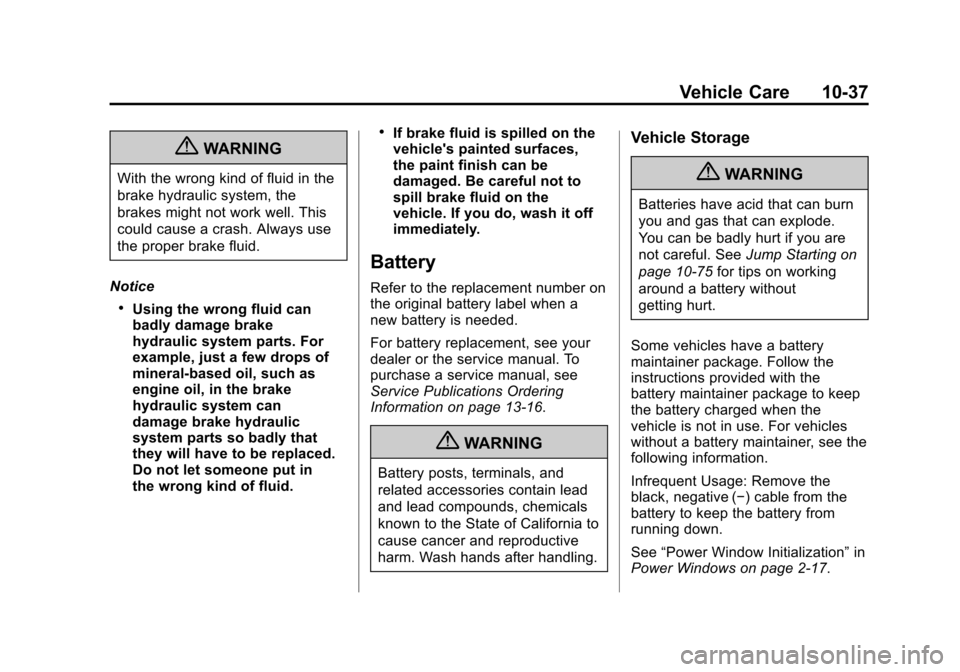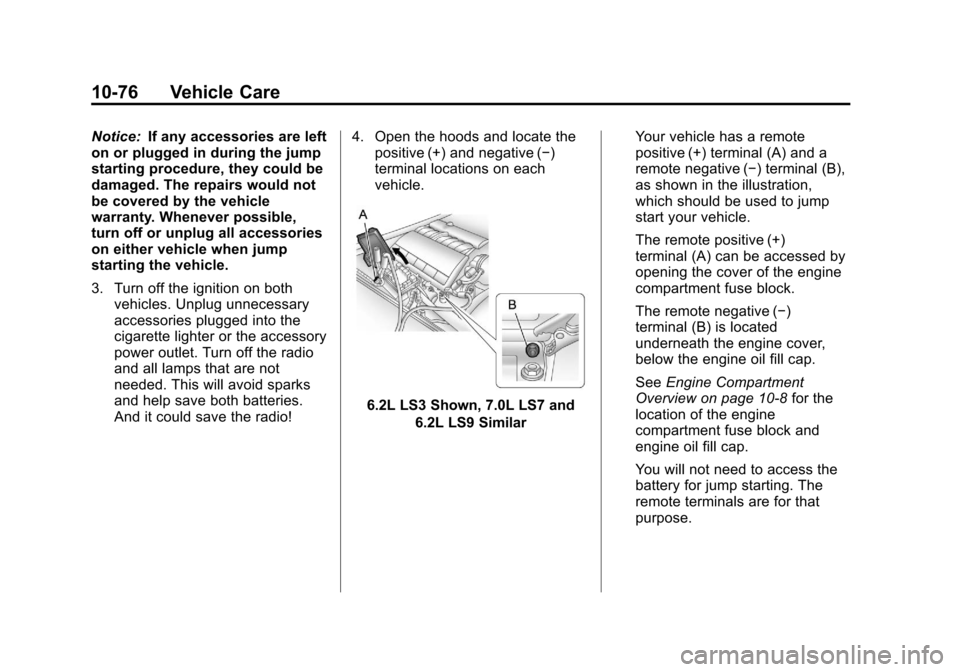Page 27 of 414

Black plate (21,1)Chevrolet Corvette Owner Manual - 2013 - crc2 - 11/8/12
In Brief 1-21
Tire Pressure Monitor
This vehicle may have a Tire
Pressure Monitor System (TPMS).
The low tire pressure warning light
alerts to a significant loss in
pressure of one of the vehicle's
tires. If the warning light comes on,
stop as soon as possible and inflate
the tires to the recommended
pressure shown on the Tire and
Loading Information label. See
Vehicle Load Limits on page 9‑12.
The warning light will remain on until
the tire pressure is corrected.
The low tire pressure warning light
may come on in cool weather when
the vehicle is first started, and then
turn off as the vehicle is driven. This
may be an early indicator that thetire pressures are getting low and
the tires need to be inflated to the
proper pressure.
The TPMS does not replace normal
monthly tire maintenance. Maintain
the correct tire pressures.
See
Tire Pressure Monitor System
on page 10‑62.
Performance Information
(Z06, ZR1, manual
transmission Grand Sport
Coupe, and 427
Convertible)
Checking Engine Oil
This vehicle has a high performance
dry sump lubrication system. This
system operates differently than a
standard engine lubrication system.
See Engine Oil on page 10‑13.
You should check the oil level only
after the engine has been
thoroughly warmed up and then shut off for at least five minutes.
This ensures that the oil level
reading obtained will be accurate.
Jump Starting the Battery
The battery is in the rear of the
vehicle. You do not need to access
the battery for jump starting. There
are remote positive (+) and negative
(−) terminals under the hood for this
purpose. See
Battery on page 10‑37
and Jump Starting on page 10‑75.
Brake Noise
Under certain weather or operating
conditions, occasional brake noise
might be heard with the vehicle's
performance braking system. This
brake system is designed for
superior fade resistance and
consistent operation using high
performance brake pads. Brake
noise is normal and does not affect
system performance.
Page 29 of 414

Black plate (23,1)Chevrolet Corvette Owner Manual - 2013 - crc2 - 11/8/12
In Brief 1-23
Battery
This vehicle has a maintenance-free
battery. SeeBattery on page 10‑37
and Jump Starting on page 10‑75.
For Z06, ZR1, manual transmission
Grand Sport Coupe, and 427
Convertible models, the battery is
located in the rear hatch/trunk area.
Access to the battery is not
necessary to jump start the vehicle.
There are positive (+) and negative
(−) terminals in the engine
compartment.
Roadside Assistance
Program
U.S.: 1-800-243-8872
TTY Users (U.S. Only):
1-888-889-2438
Canada: 1-800-268-6800
Mexico: 01-800-466-0800
New Chevrolet owners are
automatically enrolled in the
Roadside Assistance Program. See
Roadside Assistance Program
(Mexico) on page 13‑7 orRoadside
Assistance Program (U.S. and
Canada) on page 13‑10.
OnStar®
If equipped, this vehicle has a
comprehensive, in-vehicle system
that can connect to a live Advisor
for Emergency, Security, Navigation,
Connection, and Diagnostic
Services. See OnStar Overview on
page 14‑1.
Website Information
An online owner manual, owner
videos, and additional ownership
information is available at
http://www.chevrolet.com/owners/
chevy-manuals/.
Page 299 of 414

Black plate (37,1)Chevrolet Corvette Owner Manual - 2013 - crc2 - 11/8/12
Vehicle Care 10-37
{WARNING
With the wrong kind of fluid in the
brake hydraulic system, the
brakes might not work well. This
could cause a crash. Always use
the proper brake fluid.
Notice
.Using the wrong fluid can
badly damage brake
hydraulic system parts. For
example, just a few drops of
mineral-based oil, such as
engine oil, in the brake
hydraulic system can
damage brake hydraulic
system parts so badly that
they will have to be replaced.
Do not let someone put in
the wrong kind of fluid.
.If brake fluid is spilled on the
vehicle's painted surfaces,
the paint finish can be
damaged. Be careful not to
spill brake fluid on the
vehicle. If you do, wash it off
immediately.
Battery
Refer to the replacement number on
the original battery label when a
new battery is needed.
For battery replacement, see your
dealer or the service manual. To
purchase a service manual, see
Service Publications Ordering
Information on page 13‑16.
{WARNING
Battery posts, terminals, and
related accessories contain lead
and lead compounds, chemicals
known to the State of California to
cause cancer and reproductive
harm. Wash hands after handling.
Vehicle Storage
{WARNING
Batteries have acid that can burn
you and gas that can explode.
You can be badly hurt if you are
not careful. See Jump Starting on
page 10‑75 for tips on working
around a battery without
getting hurt.
Some vehicles have a battery
maintainer package. Follow the
instructions provided with the
battery maintainer package to keep
the battery charged when the
vehicle is not in use. For vehicles
without a battery maintainer, see the
following information.
Infrequent Usage: Remove the
black, negative (−) cable from the
battery to keep the battery from
running down.
See “Power Window Initialization” in
Power Windows on page 2‑17.
Page 338 of 414

Black plate (76,1)Chevrolet Corvette Owner Manual - 2013 - crc2 - 11/8/12
10-76 Vehicle Care
Notice:If any accessories are left
on or plugged in during the jump
starting procedure, they could be
damaged. The repairs would not
be covered by the vehicle
warranty. Whenever possible,
turn off or unplug all accessories
on either vehicle when jump
starting the vehicle.
3. Turn off the ignition on both
vehicles. Unplug unnecessary
accessories plugged into the
cigarette lighter or the accessory
power outlet. Turn off the radio
and all lamps that are not
needed. This will avoid sparks
and help save both batteries.
And it could save the radio! 4. Open the hoods and locate the
positive (+) and negative (−)
terminal locations on each
vehicle.
6.2L LS3 Shown, 7.0L LS7 and
6.2L LS9 Similar Your vehicle has a remote
positive (+) terminal (A) and a
remote negative (−) terminal (B),
as shown in the illustration,
which should be used to jump
start your vehicle.
The remote positive (+)
terminal (A) can be accessed by
opening the cover of the engine
compartment fuse block.
The remote negative (−)
terminal (B) is located
underneath the engine cover,
below the engine oil fill cap.
See
Engine Compartment
Overview on page 10‑8 for the
location of the engine
compartment fuse block and
engine oil fill cap.
You will not need to access the
battery for jump starting. The
remote terminals are for that
purpose.